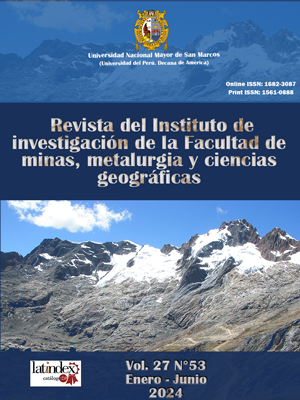Sustainable Aviation Fuel (SAF), as an alternative for the reduction of greenhouse gases in the aeronautical sector in Peru
DOI:
https://doi.org/10.15381/iigeo.v27i53.26013Keywords:
Spectral signatures, Spectral Angle Mapper, metadata, interoperability, remote sensingAbstract
The airline industry, responsible for 2.5% of global emissions of CO2 and other harmful gases, seeks to reduce its environmental impact. The increase in demand for flights has led the UK to consider a 10% increase in ticket prices to manage demand and reduce commercial flights.
Biofuels, especially Sustainable Aviation Fuel (SAF), stand out as promising alternatives as they are manufactured with renewable resources and are used in some airports. A study evaluates the benefits of SAF in reducing greenhouse gas emissions, comparing them to fossil fuels in terms of costs and performance.
In 2019, in Peru, the use of SAF demonstrated a 28% reduction in emissions. The research focuses on the viability of biofuels, especially SAF, to reduce emissions in the aviation industry.
The methodology involved comparing fossil fuel emissions with 30% SAF, made with used cooking oil, achieving a 28% reduction in greenhouse gas emissions. Despite the advantages of SAF, challenges such as high cost and comparative performance with conventional fuels are highlighted, underlining the need to address economic aspects for effective implementation.
References
Barriga, E. (2011). Diseño de módulo de transesterificación de una planta piloto para producción de biodiesel a partir de aceites usados de cocina [Tesis de grado]. Universidad Católica del Perú. https://tesis.pucp.edu.pe/repositorio/handle/20.500.12404/1021
Graver, B., Zhang, K., & Rutherford, D. (2019). Emisiones de CO2 de la aviación comercial 2018. The International council on clean transportation, v. 16. https://theicct.org/sites/default/files/publications/ICCT_CO2-commercl-aviation-2018_20190918.pdf
Cairns, S. & Carey, N. (2006). Predict and decide . Aviation, climate change and UK policy. Environmental Change Institute, p. 96. https://www.researchgate.net/publication/260584763_Predict_and_Decide_-_Aviation_Climate_Change_and_UK_Policy
Emisiones de aviones y barcos: datos y cifras (infografía).https://www.europarl.europa.eu/news/es/headlines/society/20191129STO67756/emisiones-de-aviones-y-barcos-datos-y-cifras-infografia , accedido el 8 de abril 2023.
Gonzalez-Garay, A., Heuberger-Austin, C., Fu, X., Klokkenburg, M., Zhang, D., van der Made, A., & Shah, N. (2022). Unravelling the potential of sustainable aviation fuels to decarbonise the aviation sector. Energy & Environmental Science, 15(8), 3291–3309. https://doi.org/10.1039/D1EE03437E
Noticias de Ciencia y Tecnología (2022). Impacto de la aviación en el medio ambiente. https://www.tiempo.com/ram/impacto-de-la-aviacion-en-el-medio-ambiente.html
Organización de Aviación Civil Internacional (2018). Sólido crecimiento del tráfico de pasajeros y moderación de la demanda de carga aérea en 2018. https://www.icao.int/Newsroom/Pages/Solid-passenger-traffic-growth-and-moderate-air-cargo-demand-in-2018.aspx, accedido el 16 de julio 2023.
Ministerio del Ambiente (MINAM). Reportes Sectoriales. https://infocarbono.minam.gob.pe/reportes-sectoriales/energia-2019/, accedido el 23 de julio del 2023
Downloads
Published
Issue
Section
License
Copyright (c) 2024 José Luis Bravo Artica

This work is licensed under a Creative Commons Attribution 4.0 International License.
AUTHORS RETAIN THEIR RIGHTS:
a. Authors retain their trade mark rights and patent, and also on any process or procedure described in the article.
b. Authors retain their right to share, copy, distribute, perform and publicly communicate their article (eg, to place their article in an institutional repository or publish it in a book), with an acknowledgment of its initial publication in the Rev. Inst. investig. Fac. minas metal cienc. geogr.
c. Authors retain theirs right to make a subsequent publication of their work, to use the article or any part thereof (eg a compilation of his papers, lecture notes, thesis, or a book), always indicating the source of publication (the originator of the work, journal, volume, number and date).























